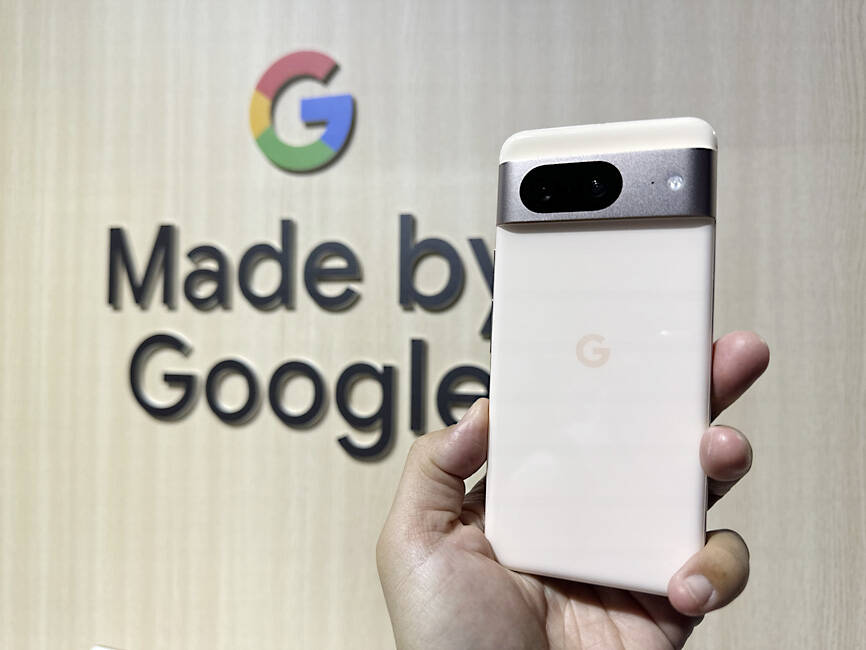Taiwan’s smartphone makers continued to feel the pinch after local market shipments in the third quarter fell more than 3 percent from a year earlier, US-based International Data Corp (IDC) said on Thursday.
Weakening demand resulting from consumers postponing replacing their phones led to Taiwan’s smartphone shipments falling 3.1 percent from a year earlier to 1.26 million units in the July-September period. This drop follows a 4.6 percent year-on-year decline in the second quarter, when shipments stood at 1.05 million units, IDC said in a statement.
However, the average selling price of smartphones in the third quarter rose 3.3 percent from a year earlier, indicating that Taiwanese smartphone manufacturers were keen to focus on producing high and medium-end devices with a higher price tag to strengthen their competitive edge in the market, IDC said.

Photo: CNA
In the third quarter, shipments of electronic wearable devices in Taiwan totaled 1.25 million units, up 2.4 percent from a year earlier, with shipments of smartwatches growing 10.2 percent from a year earlier to 300,000, it said.
Earbud shipments in Taiwan fell 2.9 percent to 770,000 units in the third quarter from a year earlier, with shipments of devices using true wireless stereo technology accounting for 92.1 percent of total earbud shipments.
The earbud segment was affected by falling consumer consumption, while demand for earwear related to smartphones also weakened, dealing a blow to the entire earbud industry, IDC said.
The smartphone market in Taiwan would continue to weaken in the wake of unfavorable economic conditions and the slow replacement of devices by consumers, with shipments next year expected to fall 2.3 percent year-on-year to 4.86 million units, IDC Taiwan associate analyst Joanne Chiang (江靖婷) said.
Due to changing foreign exchange rates, increasing costs and a continued focus on mid-range and high-end products, the average selling price is expected to grow 2.2 percent next year, she said.
Chiang also predicted shipments of wearable devices in Taiwan would grow 1.1 percent to 3.84 million units next year, with smartwatch shipments expected to rise 4.7 percent from a year earlier to 950,000 units next year.

Taiwan’s long-term economic competitiveness will hinge not only on national champions like Taiwan Semiconductor Manufacturing Co. (TSMC, 台積電) but also on the widespread adoption of artificial intelligence (AI) and other emerging technologies, a US-based scholar has said. At a lecture in Taipei on Tuesday, Jeffrey Ding, assistant professor of political science at the George Washington University and author of "Technology and the Rise of Great Powers," argued that historical experience shows that general-purpose technologies (GPTs) — such as electricity, computers and now AI — shape long-term economic advantages through their diffusion across the broader economy. "What really matters is not who pioneers

In a high-security Shenzhen laboratory, Chinese scientists have built what Washington has spent years trying to prevent: a prototype of a machine capable of producing the cutting-edge semiconductor chips that power artificial intelligence (AI), smartphones and weapons central to Western military dominance, Reuters has learned. Completed early this year and undergoing testing, the prototype fills nearly an entire factory floor. It was built by a team of former engineers from Dutch semiconductor giant ASML who reverse-engineered the company’s extreme ultraviolet lithography (EUV) machines, according to two people with knowledge of the project. EUV machines sit at the heart of a technological Cold

Taiwan Semiconductor Manufacturing Co (TSMC, 台積電) last week recorded an increase in the number of shareholders to the highest in almost eight months, despite its share price falling 3.38 percent from the previous week, Taiwan Stock Exchange data released on Saturday showed. As of Friday, TSMC had 1.88 million shareholders, the most since the week of April 25 and an increase of 31,870 from the previous week, the data showed. The number of shareholders jumped despite a drop of NT$50 (US$1.59), or 3.38 percent, in TSMC’s share price from a week earlier to NT$1,430, as investors took profits from their earlier gains

TAIWAN VALUE CHAIN: Foxtron is to fully own Luxgen following the transaction and it plans to launch a new electric model, the Foxtron Bria, in Taiwan next year Yulon Motor Co (裕隆汽車) yesterday said that its board of directors approved the disposal of its electric vehicle (EV) unit, Luxgen Motor Co (納智捷汽車), to Foxtron Vehicle Technologies Co (鴻華先進) for NT$787.6 million (US$24.98 million). Foxtron, a half-half joint venture between Yulon affiliate Hua-Chuang Automobile Information Technical Center Co (華創車電) and Hon Hai Precision Industry Co (鴻海精密), expects to wrap up the deal in the first quarter of next year. Foxtron would fully own Luxgen following the transaction, including five car distributing companies, outlets and all employees. The deal is subject to the approval of the Fair Trade Commission, Foxtron said. “Foxtron will be